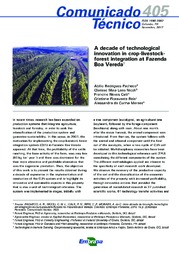A decade of technological innovation in crop-livestock-forestry integration at Fazenda Boa Vereda.
A decade of technological innovation in crop-livestock-forestry integration at Fazenda Boa Vereda.
Author(s): PACHECO, A. R.; NICOLI, C. M. L.; CALIL, F. N.; REIS, C. F.; MORAES, A. da C.
Summary: In recent times, research has been expanded on production systems that integrate agriculture, livestock and forestry, in order to seek the intensification of the production system and guarantee sustainability. In this sense, in 2007, the motivation for implementing the crop-livestock-forest integration system (CLFi) in Fazenda Boa Vereda appeared. At that time, the profitability of the cattle ranching, the base activity of the farm, was very low (60 kg ha-1 year-1) and there was disinterest for the then more attractive and profitable alternative that was the sugarcane plantation. Thus, the objective of this work is to present the results obtained during a decade of experience in the implementation and conduction of the CLFi system and to highlight its innovative and sustainable aspects in this property that is also a unit of technological reference. The system was implemented in stages, initially with a tree component (eucalypts), an agricultural one (soybean), followed by the forage component (brachiaria) along with corn. About one month after the maize harvest, the animal component was introduced. From then on, the system follows with the animal and arboreal component until the final cut of the eucalypts, when a new cycle of CLFi will be initiated. Multidisciplinary researches have been developed in this technological reference unit (TRU) considering the different components of the system. The different methodologies applied are inherent to the specificity of each research work developed. We observe the recovery of the productive capacity of the soil and the diversification of the economic activities of the property with increased profitability, through innovative actions that provided the generation of consolidated research in 37 published scientific works, 61 technology transfer activities and four honors. The optimization and efficient use of resources have been significant, with the generation of a highly competitive, sustainable and innovative system.
Publication year: 2017
Types of publication: Booklets
Unit: Embrapa Forestry
Keywords: Inovação, Transferência de tecnologia
Observation
Some of Embrapa's publications are published as ePub files. To read them, use or download one of the following free software options to your computer or mobile device. Android: Google Play Books; IOS: iBooks; Windows and Linux: Calibre.
Access other publications
Access the Agricultural Research Database (BDPA) to consult Embrapa's full library collection and records.
Visit Embrapa Bookstore to purchase books and other publications sold by Embrapa.

